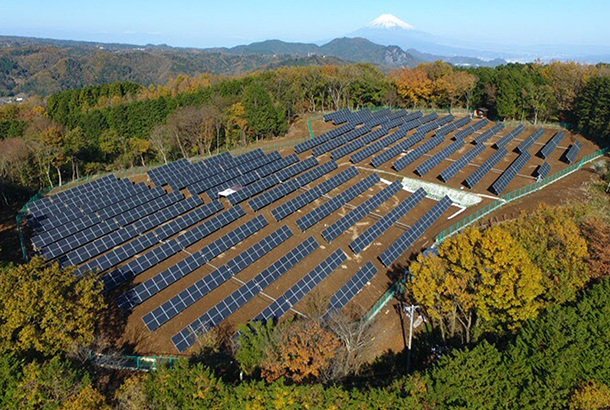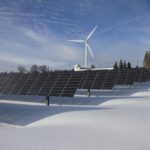

In the past few years, the large-scale deployment of solar power has faced a range of challenges. Ambitious price targets set a high bar, with rapid technological advances needed to meet these expectations. However, the industry has excelled, with installations of solar panels set to reach a record high this year.
According to recent research from BloombergNEF, wind and solar energy are now the least expensive forms of power in two-thirds of the world, and advancements in technology are pushing it towards an even brighter future.
The DNV GL energy transition outlook provides an outlook of 33 percent of all electricity being generated from solar by 2050, with all renewables totaling 80 percent of electricity generation.
Improvements in solar and storage push positive outlook
The major drawback of solar energy is that it can only function for part of the day. A 2012 study by Lawrence Berkeley National Laboratory predicted that the more solar panels deployed, the lower the value of the energy would be, as all the energy would be delivered at once and other sources of power would still be required at night.
A follow-up study in 2016 from Nature Energy forecast costs would need to fall substantially for solar to remain competitive. The study concluded that this downward trend in the value of energy produced would make solar less competitive, unless storage capacity increased substantially. However, these studies could not anticipate the massive reduction in the costs of photovoltaics (PV) and storage technologies and how efficient these plants would become.
Tech advances drive a bright future
With strong growth, particularly in many smaller markets, the solar future is bright. The industry is set to grow 17.5 percent this year alone, with decreased costs making it a more attractive proposition.
Bifacial PV modules and the expanding application of single-axis trackers are helping to fuel this growth. Bifacial modules provide additional energy as they can absorb and convert light into electricity from both sides of the module, capturing energy that reflects from the ground.
Recent projects have been announced that take advantage of bifacial modules to increase the output beyond that of traditional mono-facial systems. DNV GL are working with customers across Egypt, Brazil, Mexico and the US, all of whom are deploying bifacial modules, to drive down costs and increase the value of these PV assets.
Combining these systems with single axis-trackers designed for bifacial applications can also increase the total energy output. However, bifacial systems require additional simulations and measurements to estimate and optimize the output. The industry is making progress toward reducing the uncertainty with a growing collection of performance data from the field, which is helping us validate models and demonstrate the added value of these assets.
Sun setting on fossil fuels
Based on the 80 percent decrease in the cost of solar over the last decade, fossil fuels are becoming increasingly less competitive, particularly during peak solar production. As such, less flexible generators are being ramped down at these times, reducing revenues and profitability for existing plants, which may end up being retired earlier than anticipated. However, as the sun begins to set, generation from solar decreases, which creates a need to quickly ramp up generation from non-renewable sources to meet afternoon and evening demand.
In dynamic energy markets with high penetration of renewables, electricity prices can vary during the day and can increase dramatically during peak times with fast ramp rates needed to compensate for solar going offline. At these times, flexible generators are required to quickly deliver power. This has resulted in flexible generators, such as gas peaker plants, being compensated at higher rates thus making dispatchable resources more cost effective. However, energy storage technologies are coming of age and enabling dispatchable solar plus storage resources to address challenges associated with variable renewables.
Moreover, the cost of energy storage has decreased vastly over the last few years. This has enabled the development of more advanced solar plus storage systems. The Los Angeles Department of Water and Power recently approved a power purchase agreement for a 400 MW solar and 300 MW / 1,200 MWh battery energy storage system north of Los Angeles, California. Additionally, NV Energy in Nevada, recently signed deals for 1.2 gigawatts of PV plus nearly 600 megawatts of storage to come on-line by 2023, just outside of Las Vegas.
Continuous decreases in technology costs, combined with the development of solar plus storage plants, creates a new paradigm for setting market prices or for power purchase agreements (PPAs) that account for the time of power dispatch from these combined assets. As solar and storage costs continue to decrease and more hybrid plants are deployed, the value of flexible, non-renewable power generation will continue to erode; thereby allowing hybrid assets to extend production and address afternoon and evening loads and decrease the need for fast ramping assets in the first place. Through flexible solar energy generation assets that can be dispatched throughout the day, solar plus storage systems are set to begin redefining dynamic energy markets and reduce the historical disadvantage of solar generation.
A healthy glow
The value of renewables goes beyond just energy or climate and is being valued across adjacent industries. A recent study by MIT predicted that investments in renewable energy generation would result in a return on that investment of 34 percent in reduced healthcare costs alone due to reduced air pollution. The study focused on ten US states whose electricity generation profiles are currently made up of an average of 42 percent coal, higher than the current 30 percent US average.
The study showed that these states could reduce healthcare costs by $4.7 billion if they hit their target of 13 percent renewable energy by 2030. Remarkably, this increases to more than $20 billion if the percentage of renewable energy was doubled to what is becoming a modest 26 percent of this region’s overall electricity generation. The study estimates a $9 billion investment in renewable capacity would be needed to reach this goal.
A recent study by the National Renewable Energy Laboratory found that solar energy reduces respiratory and cardio health issues, among other health benefits. It even has been shown to reduce the number of lost work days related to health issues.
Transition to clean energy
The climate emergency is upon us and we need to act now. Renewables are often touted as a major part of the solution for climate change, which are not only readily available today, but the costs are increasingly competitive and are forecast to decrease well into the future.
These economic benefits to healthcare come about from the transition to renewable generation, which are in addition to the known economic benefits to the energy industry and the climate. The energy industry finds itself at the intersection of remarkable economic opportunities, at a time where the economy, climate, and public health are all urgently searching for solutions to systemic problems within each. Renewables are poised to deliver, through technologies that are willing and able.
The solar industry is pushing forward, but markets and regulations need to keep up to enable the transition to clean energy future.
Source: https://www.renewableenergyworld.com/2019/11/12/why-the-future-of-solar-is-bright/#gref
